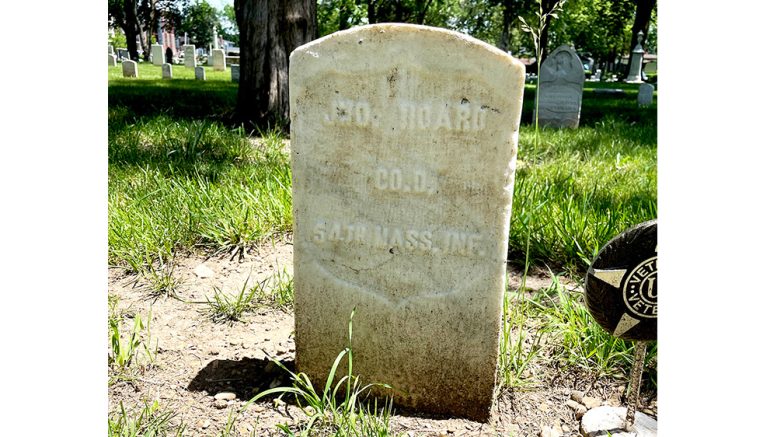The story of John Hoard
By KEVIN YANEY
Guest Columnist

You can learn a lot about the past by taking a stroll through an old cemetery. One of the fascinating nuances of living in Hamilton County is the many old cemeteries that are in our community. In particular, you can get a sense of the number of Civil War veterans who joined the war effort and what was important to them.
Riverside Cemetery in Noblesville was the city’s first and foremost burial ground from 1820 until Crownland Cemetery was established in 1867. It is the final resting place of 75 Union soldiers. According to Burgess’ Civil War Veteran Burial Guide, it is where the first and last Hamilton County veterans of the Civil War were laid to rest.
One of these soldiers is John Hoard, and his headstone tells quite a story.
As you might expect, the majority of Civil War veterans buried at Riverside were from Indiana. The state where they were living when they joined military service is carved into their headstones. Both the Union and Confederate armies were divided into similar units. The smallest unit was a company. Companies were formed locally and stayed together during the war. Companies were assigned a letter to distinguish them. They consisted of 100 men or less. Ten companies formed a regiment. Regiments were known by their state and a number. Four or five regiments were combined to form a brigade. Up to three brigades made up a division, up to four divisions made up a corps, and two or three corps made up an army. So, from the smallest to largest units would be Company – Regiment – Brigade – Division – Corps – Army. Of all the military units that defined where a soldier served, the state regiment and their local company were the most important divisions to a Civil War veteran. This is what is carved into their headstones.
That brings us back to John Hoard. The headstone of John Hoard is unique because he is listed as a member of Company D of the 54th Massachusetts Regiment. What is a guy from Massachusetts doing in Noblesville, Indiana? Most likely, John Hoard had never stepped foot in Massachusetts prior to enlisting to fight. The 54th Massachusetts was made up of African American freemen and was the first colored unit in the Federal Army.
Most people know about Abraham Lincoln’s Emancipation Proclamation. This executive order declared that any slaves in states that were part of the rebellion were declared free. This took effect on January 1, 1863, and is seen as a key turning point in the war. What many people don’t realize is that Lincoln’s proclamation also allowed African Americans to take up arms and join the Union cause.
Here is how the Proclamation states it:
“And I further declare and make known, that such persons of suitable condition, will be received into the armed service of the United States to garrison forts, positions, stations, and other places, and to man vessels of all sorts in said service.”
This caused quite a stir throughout the Confederacy. Not only was Lincoln taking away their slaves, he was also arming them to fight against the boys of the South. The leaders of the Confederacy sent a message to Lincoln that they intended to execute any black man captured in service of the Union army. Lincoln sent a message back that for every such execution, he would order a captured Confederate prisoner to be executed. These strong words were cause for concern, but Lincoln was being pushed by northern abolitionists to form a new unit of the federal army – the U.S. Colored Troops. Among those abolitionists was Frederick Douglass.
Another of these abolitionists was the governor of Massachusetts, John Andrew. Andrew stepped up and declared he would raise the first colored regiment – the Massachusetts 54th. However, Massachusetts did not have enough freemen to fill the ranks, so national recruitment began and reached as far as Noblesville, Indiana. Douglass led the recruitment.
There was a concern in the north about sending black soldiers into battle. Given the strongly worded intentions of southern leaders, would black soldiers wilt during the heat of battle? All eyes were on the Massachusetts 54th as they were sent to South Carolina. In their most celebrated action, they led a charge against Fort Wagner in Charleston Harbor on July 18, 1863. The 54th successfully breached the fort, but under heavy fire and tremendous casualties, were eventually turned back. However, the men fought valiantly, and their bravery was the spark needed for Lincoln to establish the U.S. Colored Troops. One hundred eighty thousand African American men volunteered as soldiers to fill these ranks.
That brings us back, once again, to John Hoard, a volunteer soldier in Company D of the Massachusetts 54th. He was a member of that first regiment that opened the door for so many others. He died 21 years after the Massachusetts 54th led the charge on Fort Wagner and was laid to rest at Riverside Cemetery.
If you are interested in more information, Kevin Yaney is leading a Civil War Veterans Walking Tour at Riverside Cemetery at 10 a.m. on Saturday, July 6. The event is free, but you need to register at CivilWarVeteransWalkingTour.com.

